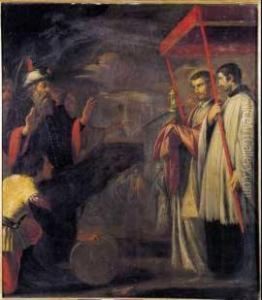Carpoforo Tencalla Paintings
Carpoforo Tencalla was an Italian painter and architect of the Baroque period, born in Bissone, now in the Swiss canton of Ticino, in 1623. He hailed from a family of artists and architects, with his father Pellegrino Tencalla also being a notable architect. Tencalla's career was primarily based in Central Europe, where he contributed significantly to the artistic landscape of his time, particularly in Austria and Hungary.
Educated in the artistic environment of his family, Tencalla likely received his initial training from his father and possibly in Italy, which was the center of the Baroque artistic movement. His early works and influences remain somewhat obscure, but it is known that he was active in Vienna by the mid-17th century. Tencalla was involved in both architectural and fresco projects, often blending the two disciplines to create immersive baroque environments.
Tencalla’s work was characterized by his skillful use of fresco technique, vivid colors, and dynamic compositions that captured the essence of the Baroque spirit—dramatic, emotive, and often monumental. His architectural work, while less documented than his fresco painting, also reflected the grandeur and ornate qualities of the period.
One of his major contributions was to the decoration of the Belvedere Palace in Vienna, where he created frescoes that were later destroyed. He also worked on commissions for various churches and palaces throughout the Habsburg Empire, including projects in Bratislava and other Slovak cities. His work in Hungary, particularly the frescoes in the Cathedral of Győr, stands as a testament to his artistic legacy.
Tencalla's influence extended through his collaboration with other artists and architects, and his role in the cultural exchange between Italy and the Central European regions where he worked. He brought the Italian Baroque style to these areas, adapting and blending it with local traditions and preferences.
Carpoforo Tencalla died in 1685, leaving behind a body of work that would influence the trajectory of Baroque art in Central Europe. Although not as widely known today as some of his contemporaries, Tencalla’s contributions to the art and architecture of the period remain significant, and his works are still studied for their artistic merit and historical importance.
